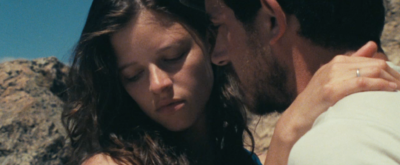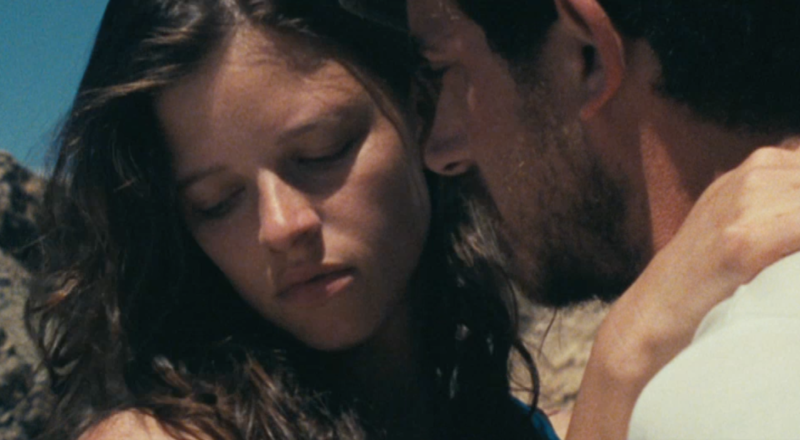INTERVIEW: ‘Somewhere Beautiful’ pays homage to Atom Egoyan’s ‘Calendar’

Somewhere Beautiful, the new movie from first-time filmmaker Albert Kodagolian, follows two storylines of people living their lives and facing monumental changes with their relationships. Kodagolian stars as a man estranged from his wife who needs to take care of his 2-year-old daughter. Alternately, the director includes scenes from a different relationship on the brink of disaster; this couple’s drama plays out in the beautiful landscapes of Patagonia on the southern tip of South America.
The two storylines do not share characters or direct connections, but they are fused together by common themes and a common inspiration: Atom Egoyan’s seminal 1993 film Calendar, which follows a couple photographing churches in Armenia and eventually breaking apart.
Kodagolian and Egoyan are friends who have known each other for some time. For his filmmaking debut, Kodagolian wanted to pay homage to Egoyan’s Calendar by following a similar structure and seeing where the framework would take him. Along for the ride is an impressive ensemble, including the well-known actor Dominique Pinon, Matilda Anna Ingrid Lutz, the legendary Pablo Cedrón and Maria Alche.
“Atom has been an incredible inspiration for me since I met him,” Kodagolian said in a recent phone interview. “When I was studying in film school, he was in the forefront of making some of the most exciting independent films at the time, and just being this young Armenian immigrant new to America and having someone like him in the world winning awards in Cannes and Sundance and Moscow, it was an incredible inspiration.”
Kodagolian first filmed the Patagonia scenes as an experimental short film. There was a limited budget with no art department, no makeup department, no lights and no production design. It was simply Kodagolian, the camera and his actors.
“Then we came back with this footage, which I didn’t see until a month or so later,” Kodagolian said. “At that point, I kept seeing Atom in Toronto or London or L.A., and then I would show him scenes. And then the conversation grew from there.”
Egoyan told Kodagolian that he found the experimental film fascinating, and now it was time to make it truly personal. “How can you make this film now really yours?” Kodagolian remembers Egoyan saying. “That’s the impetus for this whole project.”
Egoyan was flattered by the praise from his good friend. He realizes that the template for Calendar is quite simple and thus rich in possibility.
“You can take it as a theme, and like in music, there’s variation,” said Egoyan, whose other films include Exotica and The Sweet Thereafter. “So this is like a variation on this theme of emotional migration, I guess, this idea of people going to a different place, trying to negotiate their relationship to the land but also their relationship to themselves, to an image of themselves. It’s a grid in some ways. In Calendar, it’s 12 calendar images, and then what happens between the taking of these images becomes quite improvised. And so I was quite excited about the idea, and I think Albert is such an extraordinary visual artist. He had such a beautiful sense of how images work and how they function. I was excited to see what he would do with this theme, and, of course, we’re both Armenian. And I was dealing with the relationship to Armenia as a home country. … Albert, as an Armenian, went somewhere else, to Patagonia, and look at this land, this territory. He was also there for the first time.”
Kodagolian’s film, which opens at the Los Feliz Cinema in Los Angeles Friday, April 21, was not set in Armenia because Kodagolian has already been to Armenia three times: once as a child, once as a young adult and then later in life. For this film, he needed to travel places he had never been before.
“The reason Patagonia compelled me is, first of all, I met Maria Alche in London at Rough Trade Café,” Kodagolian said. “So I started talking to her, and we became really great friends. So when the idea came to do [a] Calendar [homage], I immediately called her, and I said, ‘Hey, would you like to do this film with me? It’s going to be kind of a crazy adventure because we’re going to improvise, the way Atom improvised, but we have a structure.’ She said, ‘Yes,’ and, of course, she’s the one who found Pablo Cedrón, who is an incredible, incredible legend and a great actor and a writer as well.”
Kodagolian said he loves sadness in cinema, and he has gravitated to stories of loss and stories of being a “fish out of water.” Characters who are not of a particular place interest him, and perhaps that’s because he believes himself to be a man perpetually from another place.
“In a way, I identified with Calendar when I saw it,” he said. “I thought it was an amazing structure that it created. Calendar was so fascinating on so many levels because it was dealing with identity of an Armenian from three different perspectives — an Armenian from Armenia, an Armenian who is from the diaspora but lives in the West now, and then a western Armenian who is basically more assimilated, doesn’t speak Armenian anymore but still thinks they’re Armenian. So that was quite fascinating. Of course, in mine, when we shot in Patagonia, there were no churches in Patagonia, so we had to come up with different stories that we were going to find and tell.”
This improvisational spirit paid off tremendously. There’s a scene in the Patagonia section of the film involving horses that is impressively pulled off, and the truth is that the animals simply performed their natural movements while Kodagolian’s camera was recording. It was serendipity.
“That was never written, but that happened,” Kodagolian said. “We captured it, and it became the visual theme of the film about this idea of wanting to control, not being able to, not giving up, falling down and getting back up and trying it again. So it’s kind of, I guess, a bit of a lot of great things in the film came from this openness of being not afraid to go into the unknown and just see what you will find.”
Egoyan concurred. “I think when you have a structure that is rigid, which is really like a spine, it allows you to be open in a different way,” he said.
Kodagolian only had five or six days of preparation with the actors. Everyone was excited to be in a cinematic jazz ensemble and create in real time, but when the camera started rolling, the actors wanted to know what to say.
“That’s when there needs to be someone who gives them the question and then says, ‘Look don’t worry about the answers,'” Kodagolian said. “I’m referring to one of my favorite scenes in the movie where they pull up by the side of the road, and it’s a dust storm. And then you have no idea why, what’s going on, but you know this incredible tension that has happened because of something that happened in the car a few minutes ago or during this whole trip. So, yeah, there was this openness that I wanted to experiment with, and that was part of the approach of this film. And, of course, the subject matter was being an outsider, processing loss through nostalgia, looking at cinema. Because if you think about it, one half of the movie is shot on 16mm celluloid, which is basically what documentaries used to be like, and then the other half, 35mm, which now most of us see it as the present, and then this kind of play whether this is a film within a film. Or is it memory of the past? How are these two subjects connected, and then, of course, you realize they’re completely connected by theme, which is starting to realize that there’s something you’re about to lose, which is incredibly significant and painful.”
By John Soltes / Publisher / John@HollywoodSoapbox.com
Somewhere Beautiful, directed by Albert Kodagolian and inspired by Atom Egoyan’s Calendar, is currently playing the Loz Feliz Cinema in Los Angeles. Click here for more information.

